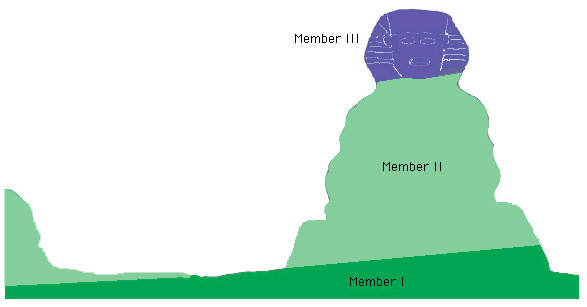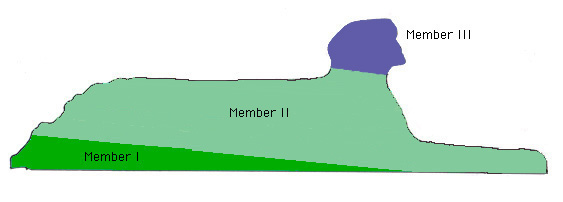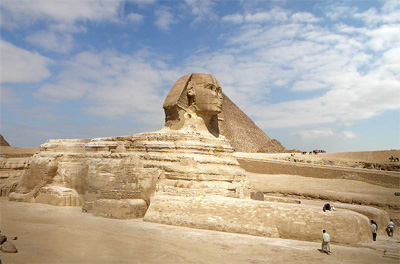The Great Sphinx of Giza. Courtesy and copyright of John Bodsworth.
The Great Sphinx of Giza, Egypt, is the largest and most famous sculpture in the world. Scholars have traditionally attributed the monument to the Egyptian King Khafra, who ruled from 2558 to 2534 BCE. In the early 1990s, the writer John Anthony West and geologist Robert Schoch claimed a prehistoric date for the Sphinx. In the late 1990s, engineering geologist Colin Reader proposed, less radically, that the Sphinx was only a few hundred years older than its conventional date. These earlier dates have provoked controversy, particularly the prehistoric one.
Since 1996, this website has tried to provide an overview of the key articles and books related to the Sphinx age debate. The website was hosted originally by Leonardo Internet (www.leonardo.net/davidpb). It moved a couple of years later to America Online (members.aol.com/davidpb4) and now resides both on my domain name site (www.davidpbillington.net) and on my America Online site.
Index
You are reading page 2 of 12. An overview of the Sphinx and its geology is located farther down this page. Page 1 is my original 1994 report. Pages 3 to 12 may be reached from the index below or through links at the top and bottom of each page. On the last three pages, I give my own reflections and tentative conclusions.
Redating the Sphinx: A Prehistoric Sphinx?
Redating the Sphinx: Geological Criticisms
Redating the Sphinx: Archaeological Criticisms
Redating the Sphinx: An Early Dynastic Sphinx?
Redating the Sphinx: The Sphinx Debate of 2000
Redating the Sphinx: The Continuing Controversy
Redating the Sphinx: Reflections on the Geology
Redating the Sphinx: Reflections on the Archaeology
Redating the Sphinx: Tentative Conclusions
Redating the Sphinx: References and Links for Further Study
I am indebted to many principals and observers in the controversy for their assistance in providing research and answering questions. All images are provided by courtesy of the person credited, who retains copyright. Images credited but not under copyright are in the public domain. Unless otherwise indicated, all drawings are my own. I regret any errors and omissions and will be happy to correct any that are brought to my attention.
The claim of a prehistoric Sphinx has been associated with other claims about the origins of civilization. On my last page, giving references for further study, I include some links to the debate over these claims for the reader who is interested.
The Sphinx

Fig. 2.1. View of the Sphinx with Khafra Pyramid in background. Courtesy and copyright of John Bodsworth.
Scholars divide ancient Egyptian civilization into six periods: the Predynastic (the ten centuries before 3050 BCE), the Early Dynastic (3050-2613), the Old Kingdom (2613-2180), the Middle Kingdom (2040-1783), the New Kingdom (1550-1070), and the Late Dynastic (1070-332). Brief intermediate periods followed the Old and Middle Kingdoms.
The traditional creator of the Sphinx, Khafra, belonged to the Fourth Dynasty (2613-2494 BCE), the first of the two dynasties that ruled the Old Kingdom. His father Khufu built the first of the three large pyramids at Giza, and Khafra's son Menkaura built the smaller third one. In recent years, the attribution of the Sphinx to Khafra has been questioned by some Egyptologists. The German scholar Rainer Stadelmann has concluded from a study of the Sphinx head that the monument was carved by Khafra's father, Khufu.[1] Other scholars defend the Khafra attribution. Mainstream scholars all agree, however, that the Sphinx dates to the Fourth Dynasty.
The Sphinx belongs to the Giza necropolis, which rests on a plateau just west of modern Cairo. The Pyramids of Khufu, Khafra, and Menkaura dominate the site (Fig. 2.2 below). The Sphinx lies at the eastern end of a stone avenue known as the Khafra Causeway. In front of (east of) the Sphinx stand the ruins of a building known as the Sphinx Temple. Adjacent and south of this temple stands a more intact structure known as the Khafra Valley Temple. At the western end of the causeway stand the remains of the Khafra Mortuary Temple, a structure adjacent to the east face of the Khafra Pyramid. Originally, each of the three large pyramids at Giza had a mortuary temple, a causeway, and a valley temple. The valley temples were close to the ancient bank of the Nile river. The Sphinx stands in an excavated hollow known as the Sphinx enclosure (Fig. 2.3 below). The statue is 240 feet long and takes the form of a recumbent lion with a human head 66 feet high. Two heavily eroded walls define the southern and western perimeter of the Sphinx enclosure (indicated by light green and light blue shading above). The walls follow the dip of the plateau. A heavily eroded northern wall only half as high in elevation (indicated by green shading above) sets apart the northern terrace, an area that was not excavated as far down as the floor on which the Sphinx stands. A narrow shelf of the terrace extends behind the Sphinx below the western enclosure wall.
The Sphinx Temple and the Khafra Valley Temple occupy a floor two and one-half meters lower than the floor on which the Sphinx stands. Along the southern side of the Khafra Valley Temple stand what appear to be the remains of a low enclosure wall (indicated by olive green shading). A northern perimeter wall may have been planned or built but no longer stands; the Sphinx Temple now occupies the site. The remains of a New Kingdom temple, oriented northeast by southwest, lie on the northern terrace above the northwest corner of the Sphinx Temple. Geologically, the Giza plateau is part of a body of limestone known as the Mokkatam Formation. The plateau was originally under water in Eocene times and the rock solidified from the remains of corals and other organic remains that settled on the bottom. The plateau today dips from the northwest to the southeast. The precise angle at the Sphinx is unclear but appears to lie between 2.5 and 5 degrees.
The monument and its enclosure cut across three beds of limestone (Figs. 2.4a and 2.4b below). The head consists of a harder limestone bed called the Akhet Member or Member III. The head may have been an outcrop standing above the original plateau or it may be the surviving rock of a layer that was removed to provide stone for the Khufu and Khafra Pyramids. The main body of the Sphinx was excavated from a weaker limestone bed called the Setepet Member or Member II. Another harder bed, the Rosetau Member or Member I, covers most of the floor and some of the lower body, rising to four meters on the rump and descending as it proceeds to the front.[2] The Sphinx and the enclosure walls have eroded over time. The Member I and Member III rock show comparatively less damage than the Member II rock, which displays severe erosion. Some of the weaker Member II strata have eroded several feet back, leaving horizontal rolls of slightly harder rock that protrude from the Sphinx and its walls (Fig. 2.5 below). These rolls are incised by vertical or diagonal joints (fractures) that have widened into fissures. A significant natural fracture, called the major fissure, transects the Sphinx body in a direction roughly NNW by SSE and separates the rear third of the body from the rest. The fissure continues across the enclosure floor to the south wall (drawn in Fig. 2.3 above). Gauri, K. Lal, Deterioration of the Stone of the Great Sphinx, The ARCE Newsletter, No. 114 (1981), pp. 35-47.
In 1979, Dr. Mark Lehner of the American Research Center in Egypt and Dr. K. Lal Gauri, director of the Stone Conservation Laboratory at the University of Louisville in Kentucky, USA, mapped the surface of the Sphinx. Gauri also removed rock samples for laboratory analysis to determine how the monument was deteriorating. He concluded that the Sphinx was slowly losing mass from a combination of weathering factors, including erosion by wind-blown sand and occasional rainfall. The primary agent of weathering, according to Gauri, was a process known as salt exfoliation.
Moisture can dissolve natural salts present in the pores of rock. When moistened salts close to the rock surface dry out in the heat of the day, they crystallize and expand inside the pores. In rock with larger pores, salt crystals do not press as severely against the pore walls. In rock with smaller pores, however, the pressure against the pore walls is more severe, weakening the surface stone. Wind and rainfall cause the weakened stone to flake off or wash away. The process then continues on freshly exposed rock. Gauri believed that subsurface groundwater seeping upward into the rock was the source of moisture, weathering the Sphinx from the inside out.
Each of the three limestone beds on the Sphinx subdivides into narrower horizontal strata. In his 1979 study, Gauri identified these strata and the distribution of pore sizes between them, and he matched these to corresponding strata on the south wall of the enclosure. He documented how strata with smaller pore sizes alternated with strata characterized by larger ones. Although overall porosity and mineral composition also played a role in how they weathered, the strata that had weathered back more severely were mainly those with smaller pore sizes. Charles Selwitz, "Deterioration of the Great Sphinx: An Assessment of the Literature," Antiquity, Vol. 64, No. 245 (December 1990), pp. 853-859.
Selwitz reported a range of studies, most carried out since the early 1980s, that also identified salt exfoliation as the principal cause of present-day weathering to the Sphinx. Selwitz noted that atmospheric moisture could also cause it. Even in an arid desert climate, there is enough moisture in the air to form condensation (dew) on exposed rock every morning, mobilizing salts in the rock. As this moisture evaporates, the salts expand and cause flaking. The climate of the twentieth century, aggravated by air pollution, may be intensifying the process of exfoliation at Giza from atmospheric effects. In addition to rain and wind-blown sand, Selwitz noted the damaging effects over time of earthquakes and the thermal effects of daily heating and cooling. Notes
1. Rainer Stadelmann, "The Great Sphinx of Giza," in Zahi Hawass, ed., Egyptology at the Dawn of the Twenty-First Century: Proceedings of the Eighth International Congress of Egyptologists, Cairo, 2000 (American University in Cairo Press, Cairo and New York, 2003), pp. 464-469. 2. The stratification of the Sphinx used here was proposed by K. Lal Gauri in "Geologic Study of the Sphinx," The ARCE Newsletter, No. 127 (1984), pp. 24-43. The illustrations in Figs. 2.3a and 2.3b are my own and are not exact or drawn to scale. ARCE stands for American Research Center in Egypt.

Fig. 2.2. Diagram of the Giza necropolis showing the Pyramids of Khufu, Khafra, and Menkaura, with associated temples and causeways. The Sphinx is to the right. Drawing is not to scale and only the surviving portions of the causeways are indicated.

Fig. 2.3. The Sphinx and its temples.
Geology of the Sphinx

Fig. 2.4a. Three bedrock layers of the Sphinx (front view).

Fig. 2.4b. Three bedrock layers of the Sphinx (side view).

Fig. 2.5. Eroded strata on the Sphinx in the 1930s. The barrier walls to the west and north of the monument have been taken down since then. Courtesy of Library of Congress.
Conservation Research
A growing concern over the deterioration of the monument has led to recent studies of how it has weathered.
Go to next page.
